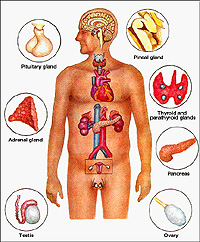Human Tissue Biology A464
 The
organs usually grouped together as the endocrine system represent
many structures with a great deal of morphological and functional
diversity. The fact that they are grouped together reflects
primarily the fact that they all secrete directly into the
extracellular space for uptake by the blood stream, rather than
delivering their products into ducts for transport to other sites,
as in the exocrine glands. Endocrine glands may be large, distinct
organs, such as those to be studied here, or scattered groups of
cells, such as the pancreatic islets, or individual cells, such as
those found in the mucosa of the digestive system. A structural
feature common to all endocrine tissues is a very rich vascular
supply. Furthermore, in spite of having origins from diverse kinds
of tissues, almost all endocrine glands are structurally epithelial
in appearance, i.e., they are composed of sheets, tubes, columns or
clusters of closely contiguous cells. A less universal feature of
endocrine cells is a content of granules suggesting the secretory
function of the cells. The
organs usually grouped together as the endocrine system represent
many structures with a great deal of morphological and functional
diversity. The fact that they are grouped together reflects
primarily the fact that they all secrete directly into the
extracellular space for uptake by the blood stream, rather than
delivering their products into ducts for transport to other sites,
as in the exocrine glands. Endocrine glands may be large, distinct
organs, such as those to be studied here, or scattered groups of
cells, such as the pancreatic islets, or individual cells, such as
those found in the mucosa of the digestive system. A structural
feature common to all endocrine tissues is a very rich vascular
supply. Furthermore, in spite of having origins from diverse kinds
of tissues, almost all endocrine glands are structurally epithelial
in appearance, i.e., they are composed of sheets, tubes, columns or
clusters of closely contiguous cells. A less universal feature of
endocrine cells is a content of granules suggesting the secretory
function of the cells.
Learning Objectives:
- Understand the functional
characteristics of endocrine cells and organs.
- Be able to distinguish the major
endocrine glands in LM.
- Distinguish the regions, zones,
and most important specific cells in the pituitary gland,
adrenal glands, thyroid gland, parathyroid gland, and the
pancreatic islets.
Pituitary gland |
|